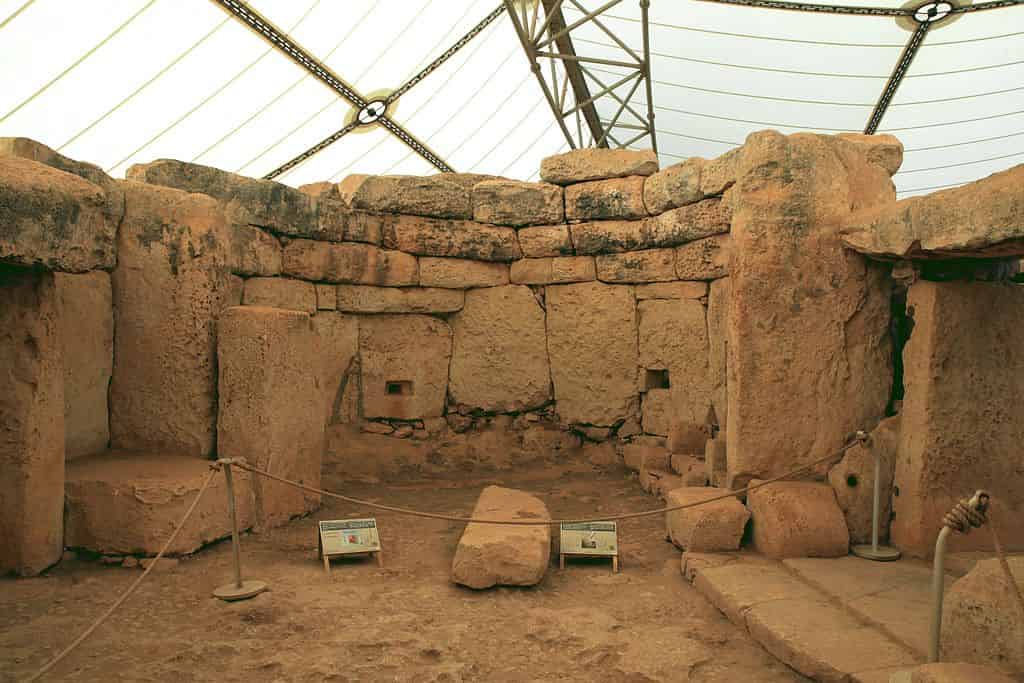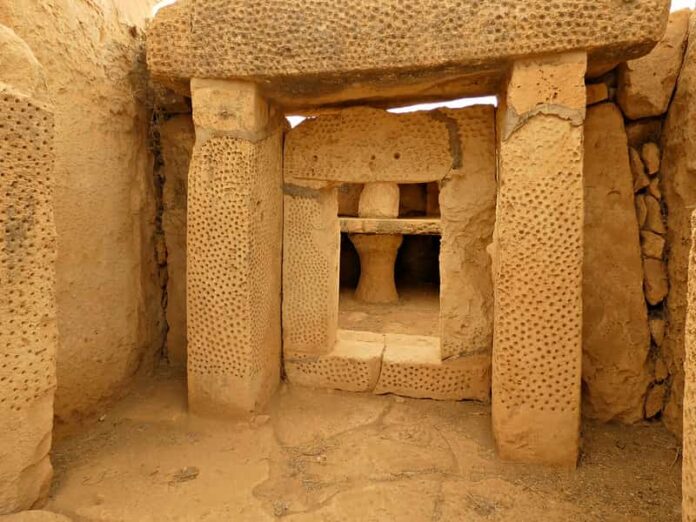Exploring the Mysteries of the Mnajdra Temples
Deep in the heart of the Mediterranean, lie prehistoric treasures. One of them is the Mnajdra Temples. These megalithic structures are on the southern coast of Malta. They’ve been standing there for a long, long time. Fascinating archaeologists, historians and visitors alike.
Let’s embark on an adventure to uncover the secrets of these ancient gems.
Discovering the Mnajdra Temples
The Mnajdra Temples are part of a large complex of ancient structures. Considered to be an architectural masterpiece. Located off the beaten track, on the outskirts of the town of Qrendi. Around 500m downhill from Ħaġar Qim.
The megalithic temples of Malta date back to prehistoric times. These were built during different prehistoric periods. Being the Neolithic and Bronze Age periods. These megalithic temples are among the oldest structures on Earth. Believed to be among the oldest freestanding stone buildings in the world. Predating even the Egyptian pyramids and Stonehenge.
These structures are known as megalithic because of their large stone structures. The Mnajdra Temple complex has three adjacent sanctuaries. Construction took place over a span of time between 3600 BC up to 2500 BC. The oldest of the Mnajdra temples dates to 3600 BC. This archaeological park is a UNESCO World Heritage site managed by Heritage Malta.
Excavation at Mnajdra started under J.G. Vance in 1840. They continued till the 20th century. Two large bowls, two small statues and tools were found on site. Excavations uncovered small altars. Which suggest a community life and spiritual practices.
Archaeologists did not find any written records about the use of these temples. Only through the objects found within these sites could they suggest the purpose for their use. These artefacts have been transferred to the National Museum of Archaeology in Valletta.
Once done visiting the temples look at the horizon. Visitors will be captivated with the view of the uninhabited islet of Filfla.

Architecture and Layout
The temples are made from massive limestone blocks. Carved and arranged to form intricate structures. The outer walls are built with coralline limestone. The inner formations are from globigerina limestone. The building techniques used are post and lintel construction. Meaning the horizontal slabs are held by large vertical stone slabs. Leaving a large space between. Another method of building used during that time involved corbelling using smaller stones. This technique involves placing stones on top of each other so that they overlap. Providing support and balance for the surrounding stones. To spread the load of the structure.
The complex consists of three separate sanctuaries which form a cloverleaf layout. Referred to as the Lower, Middle and Upper Temples. These overlook an oval forecourt. The sanctuaries are conjoined buildings but not connected together. Every sanctuary has its own entrance.
Each temple is characterised by distinct architectural features and orientation. The design of each structure is unique. Central passages lead to chambers on either side. Inside there are altars and oracles. Besides, you will find small chambers built within the thickness of the walls.
The Upper Temple
The Upper Temple is the smallest and oldest sanctuary. Constructed during the Ġgantija phase. It is a small three-apsed structure. Featuring a single chamber with a semicircular apse. Though its design is simple it still indicates a high level of craftsmanship for that period. The Upper temple is also known as the East temple due to its orientation. Here, visitors can admire the pitted large stone slabs.
The Middle Temple
Situated between the Lower and Upper Temples. The Middle Temple exhibits an intricate architectural design. It is also known as the Central Temple. Built in the early Tarxien phase around 3150 – 2500 BC.
This is the largest of the three temples. It is the most striking for its outstanding workmanship. The masonry works at this site exhibit good knowledge of building techniques. Built on a man-made elevated platform. The Central Temple features two main doorways. It consists of many chambers and apses. Decorated with intricate carved patterns and symbols. This temple has an interesting engraving on its facade. Located to the left of the passage leading to the inner apses.
The Lower Temple
The Lower Temple features a concave facade. Together with a large forecourt with stone benches. It has a trilithon entrance and a central passage leading to a series of chambers. The layout suggests a religious or ceremonial purpose. With altars and niches carved into the stone walls. It has corbelled walls which suggest that this structure was roofed. Dotted patterns and spiral carvings decorate the stone slabs.
Also, known as the South Temple. It is the most renowned of the three structures. Due to its astronomical alignment with the four seasons. Researchers believe that this temple served for astronomical observation. The orientation of this temple suggests a focus on agricultural or seasonal rituals. Reflecting the importance of the seasons to the ancient inhabitants of Malta. It highlights the significance in marking celestial events and the passage of time.
At the Spring and Autumn Equinox the sunlight passes through the main doorway. The rays light up the main axis. During the Summer Solstice the rays of the sun shine on the edge of a megalith to the left of the doorway. At the Winter Solstice the sun rays light up the megalith on the right hand side. The possible purpose of such alignment was for people to track time. For farmers to know of a change in season. To determine when they need to harvest their crops.
At sunrise on the 1st day of each season Heritage Malta organises a special event. Visitors have the opportunity to witness this sight firsthand.

Significance and Interpretations
The Mnajdra Temples have long puzzled researchers. With their precise alignments and intricate designs. While their exact purpose remains a subject of debate. Since no documents have been discovered to confirm their precise purpose. Several theories have been suggested.
Some scholars believe that the temples served as astronomical observatories. Allowing our ancestors to track the movements of the sun, moon and stars. For religious, agricultural or calendrical purposes.
Others suggest that the temples were centres of ritual activity. Where ceremonies and sacrifices were conducted to honour deities or commemorate important events. The presence of altars, niches and carved symbols supports this interpretation. Indicating a religious or spiritual function for the structures. On-site discoveries suggest this theory. Like animal bones, knives and rope holes.
Preservation and Conservation
Despite their age, the Mnajdra Temples have survived very well over the millennia. Yet, they are not immune to the ravages of time and human activity. Conservation efforts have been ongoing. To protect and preserve these ancient monuments for future generations.
The first step was to upgrade the country’s cultural heritage laws. To conserve its national monuments. The island of Malta upgraded this law in 2002.
To prevent vandalism at the Mnajdra Temples, guards were employed. Lighting was also installed and a protective fence was constructed around the site.
To preserve the site and guard it from deterioration caused by natural elements. Like water infiltration and the salty air. A protective tent was set up over the sanctuaries.
Visitor Information
The Mnajdra Temples are open to the public. Allowing visitors to explore their ancient chambers and marvel at their timeless beauty.
Start the tour at the Visitor’s Centre. With an interactive and informative 4D film. Here individuals will get detailed information on these sites. Kids can try and build a temple with blocks.
Visitors can opt for a guided tour. Guided tours provide insights into the history and significance of the temples. Offering a glimpse into Malta’s rich cultural heritage.
Visit time takes about two to three hours. It is important to wear comfortable shoes and to stay hydrated. If you intend to visit during the Summer months apply sunscreen. Wear a hat and sunglasses.
Visitors can reach the temples by public transport. From Valletta take bus Number 74. Stop at the bus stop “Ħagar”. Buses leave Valletta every 30 minutes. The journey takes about an hour. You can take bus 201 from Rabat and stop at “Ħagar”. This bus leaves Rabat every hour.
The Hop-On Hop-Off South Route makes a stop at the site.
Individuals who rent a car can drive up to site. Follow the main road to Żurrieq. Once at Żurrieq drive along the coastal road leading to Siġġiewi. On the road you can follow the signs leading to the temples. Parking is available next to the visitor centre.
Should you need further information contact the archaeological park on 21424231.
Opening Hours
During the Summer months that is from 1st April till 30th September. The sites are open from Monday to Sunday from 9am till 6pm. Winter opening hours are Monday to Sunday from 9am till 5pm. The sites are closed on the 24th, 25th and 31st December, 1st January and Good Friday.
Entrance Fees
The entrance ticket covers both Ħaġar Qim and Mnajdra. Entrance for adults is €10.00. Senior citizens, youths and students pay €7.50. Children between 6 to 11 years pay €5.50. Infants up to 5 years, Heritage Malta Passport Holders and members enter for free.
Once you are ready from visiting the megalithic temple complexes. Walk along one of the nature trails. You are sure to be captivated with stunning views. You can take a short walk to Wied iż-Żurrieq. From here visitors can board a boat trip to the famous Blue Grotto. Or you can take a longer walk to Għar Lapsi. This place is 5.9km away. Għar Lapsi is an excellent place for swimming and snorkelling. Besides, visitors can dine at one of the restaurants located here. Whilst enjoying magnificent views in a peaceful environment.
The Mnajdra Temples show how clever and skilled Malta’s ancient inhabitants were. Their precise alignments, detailed patterns and mysterious purpose keep catching people’s attention. Inspiring all who encounter them. As we learn more about these ancient structures. We start to understand more about the lasting impact of history. How people from different times and places are connected.




